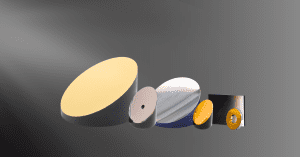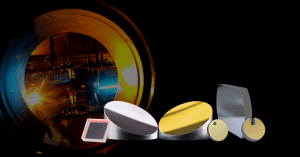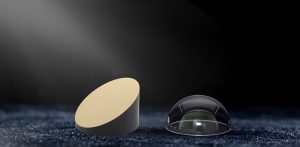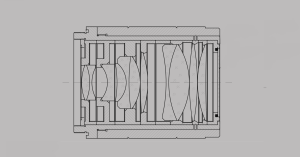Off-Axis Parabolic Mirrors
Precision off-axis parabolic (OAP) mirrors for compact, obstruction-free optical builds. They collimate a point source or focus a collimated beam—delivering high throughput and clean wavefronts in tight spaces.
What are Off-Axis Parabolic Mirrors?
- Off-Axis Segment — Cut from a larger parent paraboloid. The mirror’s optical axis is displaced from the parent’s, but the focal length and focal point remain the same.
- Purpose-Built Geometry — Smaller footprint and unique shape make the focus easy to access and integrate into complex systems.
Why Choose Off-Axis Parabolic Mirrors?
- Minimal Obstruction — Clear beam paths in folded or congested layouts.
- Compact Integration — Small, lightweight form factor simplifies packaging.
- Flexible Function — Collimates diverging sources and focuses collimated light to a point.
Avantier Capabilities
- Custom Design & Manufacturing — High-performance OAP mirrors tailored for a wide range of applications.
- Mounting Options — SM-threaded, unthreaded, or post-mountable adapters for fast, stable setup.
Looking for a specific size, focal length, or mount? Avantier can configure an OAP to your exact requirements
Manufacturing Capabilities
| Material | Aluminum |
| Diameter | 0.4~600mm |
| Diameter tolerance | +0, -0.2mm |
| Focal length tolerance | +/- 1 % |
| Off-axis distance tolerance | +6, -0mm |
| Clear Aperture | 95% |
| Surface roughness | R5nm |
| Surface accuracy | 1/10 lambda RMS |
| Surface Shape | 1/8λ |
| Surface Quality | 60-40 |
| EFL | 1.29~16000mm |
Coating Specifications
To enhance performance, Off-Axis Parabolic (OAP) mirrors are coated with specific reflective films:
Metal Coatings:
- Aluminum: Economical and durable; good UV performance with MgF₂; >80% reflectivity in the visible range.
- Silver: High reflectivity (95% visible, >97% IR); not suitable for UV; requires protection due to lower durability.
- Gold: Excellent for IR (>650 nm); high laser resistance; minimal phase delay.
Dielectric Coatings:
- Made from multilayer materials with different refractive indices.
- Offer >99.9% reflectivity, custom bandwidths, and high laser damage thresholds.
- Angle-sensitive: reflectivity peaks shift to shorter wavelengths at steeper angles.
| Material | Range(um) | % Reflection |
| Protected Aluminum | 0.4-0.7 | 85 |
| Protected Aluminum | 0.4-2.0 | 90 |
| Enhanced Aluminum | 0.45-0.65 | 95 |
| UV Enhanced Aluminum | 0.25-0.45 | 89 |
| UV Enhanced Aluminum | 0.25-0.70 | 85 |
| Protected Gold | 0.7-2.0 | 96 |
| Protected Gold | 2.0-10.0 | 96 |
| Bare Gold | 0.7-0.8 | 94 |
| Bare Gold | 0.8-2.0 | 97 |
| Bare Gold | 2.0-12.0 | 98 |
| Protected Silver | 0.45-2.0 | 98 |
| Protected Silver | 2.0-10.0 | 98 |
| Ultrafast Enhanced Silver | 0.6-1.0 | 99 |
Customization Options
Avantier offers full customization to meet your application needs, including:
- Surface figure and shape accuracy
- Reflective coating types
- Surface roughness and finish
- Special features such as central holes, slots, or mounting structures
Stock – Off-Axis Parabolic Mirrors
Protected Gold Off-Axis Parabolic Mirror
| Part Number | Diameter (mm) | Off-set Angle | EFL (mm) | RMS | Surface Roughness | Substrate | Additional Hole | Price (USD) | Delivery Time |
|---|---|---|---|---|---|---|---|---|---|
| AVT-OAP-1111 | 25.4 | 90° | 25.4 | λ/4 | 100Å | Aluminum 6061-T6 | N/A | $195.00 | In Stock |
| AVT-OAP-1211 | 25.4 | 90° | 50.8 | λ/4 | 100Å | Aluminum 6061-T6 | N/A | $190.00 | In Stock |
| AVT-OAP-1311 | 25.4 | 90° | 76.2 | λ/4 | 100Å | Aluminum 6061-T6 | N/A | $190.00 | In Stock |
| AVT-OAP-1411 | 25.4 | 90° | 101.6 | λ/4 | 100Å | Aluminum 6061-T6 | N/A | $190.00 | In Stock |
| AVT-OAP-1611 | 25.4 | 90° | 152.4 | λ/4 | 100Å | Aluminum 6061-T6 | N/A | $195.00 | In Stock |
| AVT-OAP-1811 | 25.4 | 90° | 203.2 | λ/4 | 100Å | Aluminum 6061-T6 | N/A | $195.00 | In Stock |
| AVT-OAP-2211 | 50.8 | 90° | 50.8 | λ/2 | 100Å | Aluminum 6061-T6 | N/A | $325.00 | In Stock |
| AVT-OAP-2212 | 50.8 | 90° | 50.8 | λ/2 | 100Å | Aluminum 6061-T6 | with Ø3 mm Hole Parallel to Focused Beam | $335.00 | In Stock |
| AVT-OAP-2311 | 50.8 | 90° | 76.2 | λ/2 | 100Å | Aluminum 6061-T6 | N/A | $325.00 | In Stock |
| AVT-OAP-2411 | 50.8 | 90° | 101.6 | λ/2 | 100Å | Aluminum 6061-T6 | N/A | $325.00 | In Stock |
| AVT-OAP-2412 | 50.8 | 90° | 101.6 | λ/2 | 100Å | Aluminum 6061-T6 | with Ø3 mm Hole Parallel to Focused Beam | $335.00 | In Stock |
| AVT-OAP-2611 | 50.8 | 90° | 152.4 | λ/2 | 100Å | Aluminum 6061-T6 | N/A | $325.00 | In Stock |
| AVT-OAP-2612 | 50.8 | 90° | 152.4 | λ/2 | 100Å | Aluminum 6061-T6 | with Ø3 mm Hole Parallel to Focused Beam | $335.00 | In Stock |
Protected Silver Off-Axis Parabolic Mirror
| Part Number | Diameter (mm) | Off-Set Angle | EFL (mm) | RMS | Surface Roughness | Substrate | Additional Hole | Price(USD) | Delivery Time |
|---|---|---|---|---|---|---|---|---|---|
| AVT-OAP-1121 | 25.4 | 90° | 25.4 | λ/4 | 100Å | Aluminum 6061-T6 | N/A | $190.00 | In Stock |
| AVT-OAP-1221 | 25.4 | 90° | 50.8 | λ/4 | 100Å | Aluminum 6061-T6 | N/A | $185.00 | In Stock |
| AVT-OAP-1321 | 25.4 | 90° | 76.2 | λ/4 | 100Å | Aluminum 6061-T6 | N/A | $185.00 | In Stock |
| AVT-OAP-1421 | 25.4 | 90° | 101.6 | λ/4 | 100Å | Aluminum 6061-T6 | N/A | $185.00 | In Stock |
| AVT-OAP-1621 | 25.4 | 90° | 152.4 | λ/4 | 100Å | Aluminum 6061-T6 | N/A | $185.00 | In Stock |
| AVT-OAP-1821 | 25.4 | 90° | 203.2 | λ/4 | 100Å | Aluminum 6061-T6 | N/A | $185.00 | In Stock |
| AVT-OAP-2221 | 50.8 | 90° | 50.8 | λ/2 | 100Å | Aluminum 6061-T6 | N/A | $285.00 | In Stock |
| AVT-OAP-2222 | 50.8 | 90° | 50.8 | λ/2 | 100Å | Aluminum 6061-T6 | with Ø3 mm Hole Parallel to Focused Beam | $300.00 | In Stock |
| AVT-OAP-2321 | 50.8 | 90° | 76.2 | λ/2 | 100Å | Aluminum 6061-T6 | N/A | $285.00 | In Stock |
| AVT-OAP-2421 | 50.8 | 90° | 101.6 | λ/2 | 100Å | Aluminum 6061-T6 | N/A | $285.00 | In Stock |
| AVT-OAP-2422 | 50.8 | 90° | 101.6 | λ/2 | 100Å | Aluminum 6061-T6 | with Ø3 mm Hole Parallel to Focused Beam | $300.00 | In Stock |
| AVT-OAP-2621 | 50.8 | 90° | 152.4 | λ/2 | 100Å | Aluminum 6061-T6 | N/A | $285.00 | In Stock |
| AVT-OAP-2622 | 50.8 | 90° | 152.4 | λ/2 | 100Å | Aluminum 6061-T6 | with Ø3 mm Hole Parallel to Focused Beam | $300.00 | In Stock |
Protected Aluminium Off-Axis Parabolic Mirror
| Part Number | Diameter (mm) | Off-Set Angle | EFL (mm) | RMS | Surface Roughness | Substrate | Additional Hole | Price(USD) | Delivery Time |
|---|---|---|---|---|---|---|---|---|---|
| AVT-OAP-1131 | 25.4 | 90° | 25.4 | λ/4 | 100Å | Aluminum 6061-T6 | N/A | $185.00 | In Stock |
| AVT-OAP-1231 | 25.4 | 90° | 50.8 | λ/4 | 100Å | Aluminum 6061-T6 | N/A | $180.00 | In Stock |
| AVT-OAP-1331 | 25.4 | 90° | 76.2 | λ/4 | 100Å | Aluminum 6061-T6 | N/A | $180.00 | In Stock |
| AVT-OAP-1431 | 25.4 | 90° | 101.6 | λ/4 | 100Å | Aluminum 6061-T6 | N/A | $180.00 | In Stock |
| AVT-OAP-1631 | 25.4 | 90° | 152.4 | λ/4 | 100Å | Aluminum 6061-T6 | N/A | $185.00 | In Stock |
| AVT-OAP-1831 | 25.4 | 90° | 203.2 | λ/4 | 100Å | Aluminum 6061-T6 | N/A | $185.00 | In Stock |
| AVT-OAP-2231 | 50.8 | 90° | 50.8 | λ/2 | 100Å | Aluminum 6061-T6 | N/A | $285.00 | In Stock |
| AVT-OAP-2331 | 50.8 | 90° | 76.2 | λ/2 | 100Å | Aluminum 6061-T6 | N/A | $285.00 | In Stock |
| AVT-OAP-2431 | 50.8 | 90° | 101.6 | λ/2 | 100Å | Aluminum 6061-T6 | N/A | $285.00 | In Stock |
| AVT-OAP-2631 | 50.8 | 90° | 152.4 | λ/2 | 100Å | Aluminum 6061-T6 | N/A | $285.00 | In Stock |
UV-Enhanced Aluminum Off-Axis Parabolic Mirror
| Part Number | Diameter (mm) | Off-Set Angle | EFL (mm) | RMS | Surface Roughness | Substrate | Additional Hole | Price(USD) | Delivery Time |
|---|---|---|---|---|---|---|---|---|---|
| AVT-OAP-1141 | 25.4 | 90° | 25.4 | λ/4 | 100Å | Aluminum 6061-T6 | N/A | $185.00 | In Stock |
| AVT-OAP-1241 | 25.4 | 90° | 50.8 | λ/4 | 100Å | Aluminum 6061-T6 | N/A | $180.00 | In Stock |
| AVT-OAP-1341 | 25.4 | 90° | 76.2 | λ/4 | 100Å | Aluminum 6061-T6 | N/A | $180.00 | In Stock |
| AVT-OAP-1441 | 25.4 | 90° | 101.6 | λ/4 | 100Å | Aluminum 6061-T6 | N/A | $180.00 | In Stock |
| AVT-OAP-1641 | 25.4 | 90° | 152.4 | λ/4 | 100Å | Aluminum 6061-T6 | N/A | $185.00 | In Stock |
| AVT-OAP-1841 | 25.4 | 90° | 203.2 | λ/4 | 100Å | Aluminum 6061-T6 | N/A | $185.00 | In Stock |
| AVT-OAP-2241 | 50.8 | 90° | 50.8 | λ/2 | 100Å | Aluminum 6061-T6 | N/A | $285.00 | In Stock |
| AVT-OAP-2242 | 50.8 | 90° | 50.8 | λ/2 | 100Å | Aluminum 6061-T6 | with Ø3 mm Hole Parallel to Focused Beam | $290.00 | In Stock |
| AVT-OAP-2341 | 50.8 | 90° | 76.2 | λ/2 | 100Å | Aluminum 6061-T6 | N/A | $285.00 | In Stock |
| AVT-OAP-2441 | 50.8 | 90° | 101.6 | λ/2 | 100Å | Aluminum 6061-T6 | N/A | $285.00 | In Stock |
| AVT-OAP-2442 | 50.8 | 90° | 101.6 | λ/2 | 100Å | Aluminum 6061-T6 | with Ø3 mm Hole Parallel to Focused Beam | $290.00 | In Stock |
| AVT-OAP-2641 | 50.8 | 90° | 152.4 | λ/2 | 100Å | Aluminum 6061-T6 | N/A | $285.00 | In Stock |
| AVT-OAP-2642 | 50.8 | 90° | 152.4 | λ/2 | 100Å | Aluminum 6061-T6 | with Ø3 mm Hole Parallel to Focused Beam | $290.00 | In Stock |
Advanced OAP Mirrors
| Part Number | RoC | k | OAD | OAA (°) | D (mm) | CA | fp | fs | Best FitSphere | Departure to Sphere | Price (USD) MOQ 5 pcs | Price (USD) MOQ 10 pcs |
|---|---|---|---|---|---|---|---|---|---|---|---|---|
| OAP12-50-90-G | 50.000 | -1 | 50.000 | 90 | 12.7 | 11 | 25.000 | 50 | 106.158 | 0.198 | $270.00 | $235.00 |
| OAP25-50-90-G | 50.000 | -1 | 50.000 | 90 | 25.4 | 23 | 25.000 | 50 | 106.440 | 0.822 | $330.00 | $290.00 |
| OAP38-50-90-G | 50.000 | -1 | 50.000 | 90 | 38.1 | 34 | 25.000 | 50 | 106.924 | 1.911 | $385.00 | $350.00 |
| OAP12-100-30-G | 186.603 | -1 | 50.000 | 30 | 12.7 | 11 | 93.301 | 100 | 200.170 | 0.008 | $270.00 | $235.00 |
| OAP25-100-30-G | 186.603 | -1 | 50.000 | 30 | 25.4 | 23 | 93.301 | 100 | 200.322 | 0.031 | $330.00 | $290.00 |
| OAP38-100-30-G | 186.603 | -1 | 50.000 | 30 | 38.1 | 34 | 93.301 | 100 | 200.578 | 0.073 | $385.00 | $350.00 |
| OAP12-100-45-G | 170.711 | -1 | 70.711 | 45 | 12.7 | 11 | 85.355 | 100 | 200.678 | 0.018 | $270.00 | $235.00 |
| OAP25-100-45-G | 170.711 | -1 | 70.711 | 45 | 25.4 | 23 | 85.355 | 100 | 200.831 | 0.073 | $330.00 | $290.00 |
| OAP38-100-45-G | 170.711 | -1 | 70.711 | 45 | 38.1 | 34 | 85.355 | 100 | 201.090 | 0.169 | $385.00 | $250.00 |
| OAP50-100-45-G | 170.711 | -1 | 70.711 | 45 | 50.8 | 46 | 85.355 | 100 | 201.444 | 0.308 | $505.00 | $445.00 |
| OAP12-100-60-G | 150.000 | -1 | 86.603 | 60 | 12.7 | 11 | 75.000 | 100 | 202.123 | 0.034 | $270.00 | $235.00 |
| OAP25-100-60-G | 150.000 | -1 | 86.603 | 60 | 25.4 | 23 | 75.000 | 100 | 202.277 | 0.139 | $330.00 | $290.00 |
| OAP38-100-60-G | 150.000 | -1 | 86.603 | 60 | 38.1 | 34 | 75.000 | 100 | 202.538 | 0.321 | $385.00 | $350.00 |
| OAP50-100-60-G | 150.000 | -1 | 86.603 | 60 | 50.8 | 46 | 75.000 | 100 | 202.893 | 0.582 | $505.00 | $445.00 |
| OAP76-100-60-G | 150.000 | -1 | 86.603 | 60 | 76.2 | 69 | 75.000 | 100 | 203.930 | 1.360 | $695.00 | $640.00 |
| OAP12-100-90-G | 100.000 | -1 | 100.000 | 90 | 12.7 | 11 | 50.000 | 100 | 212.176 | 0.097 | $270.00 | $235.00 |
| OAP25-100-90-G | 100.000 | -1 | 100.000 | 90 | 25.4 | 23 | 50.000 | 100 | 212.316 | 0.396 | $330.00 | $290.00 |
| OAP38-100-90-G | 100.000 | -1 | 100.000 | 90 | 38.1 | 34 | 50.000 | 100 | 212.560 | 0.908 | $385.00 | $350.00 |
| OAP50-100-90-G | 100.000 | -1 | 100.000 | 90 | 50.8 | 46 | 50.000 | 100 | 212.880 | 1.644 | $505.00 | $445.00 |
| OAP76-100-90-G | 100.000 | -1 | 100.000 | 90 | 76.2 | 69 | 50.000 | 100 | 213.848 | 3.822 | $695.00 | $640.00 |
| OAP12-150-30-G | 279.904 | -1 | 75.000 | 30 | 12.7 | 11 | 139.952 | 150 | 300.214 | 0.005 | $270.00 | $235.00 |
| OAP25-150-30-G | 279.904 | -1 | 75.000 | 30 | 25.4 | 23 | 139.952 | 150 | 300.315 | 0.020 | $330.00 | $290.00 |
| OAP38-150-30-G | 279.904 | -1 | 75.000 | 30 | 38.1 | 34 | 139.952 | 150 | 300.485 | 0.047 | $385.00 | $350.00 |
| OAP50-150-30-G | 279.904 | -1 | 75.000 | 30 | 50.8 | 46 | 139.952 | 150 | 300.720 | 0.086 | $505.00 | $445.00 |
| OAP12-150-45-G | 256.066 | -1 | 106.066 | 45 | 12.7 | 11 | 128.033 | 150 | 300.974 | 0.012 | $270.00 | $235.00 |
| OAP25-150-45-G | 256.066 | -1 | 106.066 | 45 | 25.4 | 23 | 128.033 | 150 | 301.076 | 0.048 | $330.00 | $290.00 |
| OAP38-150-45-G | 256.066 | -1 | 106.066 | 45 | 38.1 | 34 | 128.033 | 150 | 301.249 | 0.110 | $385.00 | $350.00 |
| OAP50-150-45-G | 256.066 | -1 | 106.066 | 45 | 50.8 | 46 | 128.033 | 150 | 301.484 | 0.198 | $505.00 | $445.00 |
| OAP76-150-45-G | 256.066 | -1 | 106.066 | 45 | 76.2 | 69 | 128.033 | 150 | 302.173 | 0.462 | $695.00 | $640.00 |
| OAP12-150-60-G | 225.000 | -1 | 129.904 | 60 | 12.7 | 11 | 112.500 | 150 | 303.142 | 0.023 | $270.00 | $235.00 |
| OAP25-150-60-G | 225.000 | -1 | 129.904 | 60 | 25.4 | 23 | 112.500 | 150 | 303.244 | 0.092 | $330.00 | $290.00 |
| OAP38-150-60-G | 225.000 | -1 | 129.904 | 60 | 38.1 | 34 | 112.500 | 150 | 303.419 | 0.209 | $385.00 | $350.00 |
| OAP50-150-60-G | 225.000 | -1 | 129.904 | 60 | 50.8 | 46 | 112.500 | 150 | 303.654 | 0.377 | $505.00 | $445.00 |
| OAP76-150-60-G | 225.000 | -1 | 129.904 | 60 | 76.2 | 69 | 112.500 | 150 | 304.348 | 0.873 | $695.00 | $640.00 |
| OAP12-150-90-G | 150.000 | -1 | 150.000 | 90 | 12.7 | 11 | 75.000 | 150 | 318.227 | 0.064 | $270.00 | $235.00 |
| OAP25-150-90-G | 150.000 | -1 | 150.000 | 90 | 25.4 | 23 | 75.000 | 150 | 318.319 | 0.261 | $330.00 | $290.00 |
| OAP38-150-90-G | 150.000 | -1 | 150.000 | 90 | 38.1 | 34 | 75.000 | 150 | 318.483 | 0.594 | $385.00 | $350.00 |
| OAP50-150-90-G | 150.000 | -1 | 150.000 | 90 | 50.8 | 46 | 75.000 | 150 | 318.692 | 1.070 | $505.00 | $445.00 |
| OAP76-150-90-G | 150.000 | -1 | 150.000 | 90 | 76.2 | 69 | 75.000 | 150 | 319.339 | 2.465 | $695.00 | $640.00 |
| OAP12-200-30-G | 373.205 | -1 | 100.000 | 30 | 12.7 | 11 | 186.603 | 200 | 400.265 | 0.004 | $270.00 | $235.00 |
| OAP25-200-30-G | 373.205 | -1 | 100.000 | 30 | 25.4 | 23 | 186.603 | 200 | 400.341 | 0.015 | $330.00 | $290.00 |
| OAP38-200-30-G | 373.205 | -1 | 100.000 | 30 | 38.1 | 34 | 186.603 | 200 | 400.469 | 0.035 | $385.00 | $350.00 |
| OAP50-200-30-G | 373.205 | -1 | 100.000 | 30 | 50.8 | 46 | 186.603 | 200 | 400.644 | 0.063 | $505.00 | $445.00 |
| OAP76-200-30-G | 373.205 | -1 | 100.000 | 30 | 76.2 | 69 | 186.603 | 200 | 401.156 | 0.146 | $695.00 | $640.00 |
| OAP12-200-45-G | 341.421 | -1 | 141.421 | 45 | 12.7 | 11 | 170.711 | 200 | 401.279 | 0.009 | $290.00 | $250.44 |
| OAP25-200-45-G | 341.421 | -1 | 141.421 | 45 | 25.4 | 23 | 170.711 | 200 | 401.355 | 0.036 | $350.00 | $310.00 |
| OAP38-200-45-G | 341.421 | -1 | 141.421 | 45 | 38.1 | 34 | 170.711 | 200 | 401.485 | 0.081 | $405.00 | $370.00 |
| OAP50-200-45-G | 341.421 | -1 | 141.421 | 45 | 50.8 | 46 | 170.711 | 200 | 401.661 | 0.146 | $520.00 | $465.00 |
| OAP76-200-45-G | 341.421 | -1 | 141.421 | 45 | 76.2 | 69 | 170.711 | 200 | 402.178 | 0.337 | $715.00 | $655.00 |
| OAP12-200-60-G | 300.000 | -1 | 173.205 | 60 | 12.7 | 11 | 150.000 | 200 | 404.170 | 0.017 | $310.00 | $270.00 |
| OAP25-200-60-G | 300.000 | -1 | 173.205 | 60 | 25.4 | 23 | 150.000 | 200 | 404.246 | 0.068 | $370.00 | $330.00 |
| OAP38-200-60-G | 300.000 | -1 | 173.205 | 60 | 38.1 | 34 | 150.000 | 200 | 404.378 | 0.155 | $425.00 | $385.00 |
| OAP50-200-60-G | 300.000 | -1 | 173.205 | 60 | 50.8 | 46 | 150.000 | 200 | 404.552 | 0.279 | $540.00 | $485.00 |
| OAP76-200-60-G | 300.000 | -1 | 173.205 | 60 | 76.2 | 69 | 150.000 | 200 | 405.075 | 0.641 | $735.00 | $675.00 |
| OAP12-300-30-G | 559.808 | -1 | 150.000 | 30 | 12.7 | 11 | 279.904 | 300 | 600.377 | 0.002 | $330.00 | $290.00 |
| OAP25-300-30-G | 559.808 | -1 | 150.000 | 30 | 25.4 | 23 | 279.904 | 300 | 600.427 | 0.010 | $385.00 | $350.00 |
| OAP38-300-30-G | 559.808 | -1 | 150.000 | 30 | 38.1 | 34 | 279.904 | 300 | 600.513 | 0.023 | $445.00 | $405.00 |
| OAP50-300-30-G | 559.808 | -1 | 150.000 | 30 | 50.8 | 46 | 279.904 | 300 | 600.629 | 0.041 | $560.00 | $505.00 |
| OAP76-300-30-G | 559.808 | -1 | 150.000 | 30 | 76.2 | 69 | 279.904 | 300 | 600.971 | 0.094 | $755.00 | $695.00 |
| Part Number | RoC | k | OAD | OAA (°) | D (mm) | CA | fp | fs | Best FitSphere | Departure to Sphere | Price (USD) MOQ 5 pcs | Price (USD) MOQ 10 pcs |
|---|---|---|---|---|---|---|---|---|---|---|---|---|
| OAP12-50-90-AL | 50.000 | -1 | 50.000 | 90 | 12.7 | 11 | 25.000 | 50 | 106.158 | 0.198 | $235.00 | $195.00 |
| OAP25-50-90-AL | 50.000 | -1 | 50.000 | 90 | 25.4 | 23 | 25.000 | 50 | 106.440 | 0.822 | $290.00 | $250.00 |
| OAP38-50-90-AL | 50.000 | -1 | 50.000 | 90 | 38.1 | 34 | 25.000 | 50 | 106.924 | 1.911 | $350.00 | $310.00 |
| OAP12-100-30-AL | 186.603 | -1 | 50.000 | 30 | 12.7 | 11 | 93.301 | 100 | 200.170 | 0.008 | $235.00 | $195.00 |
| OAP25-100-30-AL | 186.603 | -1 | 50.000 | 30 | 25.4 | 23 | 93.301 | 100 | 200.322 | 0.031 | $290.00 | $250.00 |
| OAP38-100-30-AL | 186.603 | -1 | 50.000 | 30 | 38.1 | 34 | 93.301 | 100 | 200.578 | 0.073 | $350.00 | $310.00 |
| OAP12-100-45-AL | 170.711 | -1 | 70.711 | 45 | 12.7 | 11 | 85.355 | 100 | 200.678 | 0.018 | $235.00 | $195.00 |
| OAP25-100-45-AL | 170.711 | -1 | 70.711 | 45 | 25.4 | 23 | 85.355 | 100 | 200.831 | 0.073 | $290.00 | $250.00 |
| OAP38-100-45-AL | 170.711 | -1 | 70.711 | 45 | 38.1 | 34 | 85.355 | 100 | 201.090 | 0.169 | $350.00 | $310.00 |
| OAP50-100-45-AL | 170.711 | -1 | 70.711 | 45 | 50.8 | 46 | 85.355 | 100 | 201.444 | 0.308 | $465.00 | $405.00 |
| OAP12-100-60-AL | 150.000 | -1 | 86.603 | 60 | 12.7 | 11 | 75.000 | 100 | 202.123 | 0.034 | $235.00 | $195.00 |
| OAP25-100-60-AL | 150.000 | -1 | 86.603 | 60 | 25.4 | 23 | 75.000 | 100 | 202.277 | 0.139 | $290.00 | $250.00 |
| OAP38-100-60-AL | 150.000 | -1 | 86.603 | 60 | 38.1 | 34 | 75.000 | 100 | 202.538 | 0.321 | $350.00 | $310.00 |
| OAP50-100-60-AL | 150.000 | -1 | 86.603 | 60 | 50.8 | 46 | 75.000 | 100 | 202.893 | 0.582 | $465.00 | $405.00 |
| OAP76-100-60-AL | 150.000 | -1 | 86.603 | 60 | 76.2 | 69 | 75.000 | 100 | 203.930 | 1.360 | $655.00 | $600.00 |
| OAP12-100-90-AL | 100.000 | -1 | 100.000 | 90 | 12.7 | 11 | 50.000 | 100 | 212.176 | 0.097 | $235.00 | $195.00 |
| OAP25-100-90-AL | 100.000 | -1 | 100.000 | 90 | 25.4 | 23 | 50.000 | 100 | 212.316 | 0.396 | $290.00 | $250.00 |
| OAP38-100-90-AL | 100.000 | -1 | 100.000 | 90 | 38.1 | 34 | 50.000 | 100 | 212.560 | 0.908 | $350.00 | $310.00 |
| OAP50-100-90-AL | 100.000 | -1 | 100.000 | 90 | 50.8 | 46 | 50.000 | 100 | 212.880 | 1.644 | $465.00 | $405.00 |
| OAP76-100-90-AL | 100.000 | -1 | 100.000 | 90 | 76.2 | 69 | 50.000 | 100 | 213.848 | 3.822 | $655.00 | $600.00 |
| OAP12-150-30-AL | 279.904 | -1 | 75.000 | 30 | 12.7 | 11 | 139.952 | 150 | 300.214 | 0.005 | $235.00 | $195.00 |
| OAP25-150-30-AL | 279.904 | -1 | 75.000 | 30 | 25.4 | 23 | 139.952 | 150 | 300.315 | 0.020 | $290.00 | $250.00 |
| OAP38-150-30-AL | 279.904 | -1 | 75.000 | 30 | 38.1 | 34 | 139.952 | 150 | 300.485 | 0.047 | $350.00 | $310.00 |
| OAP50-150-30-AL | 279.904 | -1 | 75.000 | 30 | 50.8 | 46 | 139.952 | 150 | 300.720 | 0.086 | $465.00 | $405.00 |
| OAP12-150-45-AL | 256.066 | -1 | 106.066 | 45 | 12.7 | 11 | 128.033 | 150 | 300.974 | 0.012 | $235.00 | $195.00 |
| OAP25-150-45-AL | 256.066 | -1 | 106.066 | 45 | 25.4 | 23 | 128.033 | 150 | 301.076 | 0.048 | $290.00 | $250.00 |
| OAP38-150-45-AL | 256.066 | -1 | 106.066 | 45 | 38.1 | 34 | 128.033 | 150 | 301.249 | 0.110 | $350.00 | $310.00 |
| OAP50-150-45-AL | 256.066 | -1 | 106.066 | 45 | 50.8 | 46 | 128.033 | 150 | 301.484 | 0.198 | $465.00 | $405.00 |
| OAP76-150-45-AL | 256.066 | -1 | 106.066 | 45 | 76.2 | 69 | 128.033 | 150 | 302.173 | 0.462 | $655.00 | $600.00 |
| OAP12-150-60-AL | 225.000 | -1 | 129.904 | 60 | 12.7 | 11 | 112.500 | 150 | 303.142 | 0.023 | $235.00 | $195.00 |
| OAP25-150-60-AL | 225.000 | -1 | 129.904 | 60 | 25.4 | 23 | 112.500 | 150 | 303.244 | 0.092 | $290.00 | $250.00 |
| OAP38-150-60-AL | 225.000 | -1 | 129.904 | 60 | 38.1 | 34 | 112.500 | 150 | 303.419 | 0.209 | $350.00 | $310.00 |
| OAP50-150-60-AL | 225.000 | -1 | 129.904 | 60 | 50.8 | 46 | 112.500 | 150 | 303.654 | 0.377 | $465.00 | $405.00 |
| OAP76-150-60-AL | 225.000 | -1 | 129.904 | 60 | 76.2 | 69 | 112.500 | 150 | 304.348 | 0.873 | $655.00 | $600.00 |
| OAP12-150-90-AL | 150.000 | -1 | 150.000 | 90 | 12.7 | 11 | 75.000 | 150 | 318.227 | 0.064 | $235.00 | $195.00 |
| OAP25-150-90-AL | 150.000 | -1 | 150.000 | 90 | 25.4 | 23 | 75.000 | 150 | 318.319 | 0.261 | $290.00 | $250.00 |
| OAP38-150-90-AL | 150.000 | -1 | 150.000 | 90 | 38.1 | 34 | 75.000 | 150 | 318.483 | 0.594 | $350.00 | $310.00 |
| OAP50-150-90-AL | 150.000 | -1 | 150.000 | 90 | 50.8 | 46 | 75.000 | 150 | 318.692 | 1.070 | $465.00 | $405.00 |
| OAP76-150-90-AL | 150.000 | -1 | 150.000 | 90 | 76.2 | 69 | 75.000 | 150 | 319.339 | 2.465 | $655.00 | $600.00 |
| OAP12-200-30-AL | 373.205 | -1 | 100.000 | 30 | 12.7 | 11 | 186.603 | 200 | 400.265 | 0.004 | $235.00 | $195.00 |
| OAP25-200-30-AL | 373.205 | -1 | 100.000 | 30 | 25.4 | 23 | 186.603 | 200 | 400.341 | 0.015 | $290.00 | $250.00 |
| OAP38-200-30-AL | 373.205 | -1 | 100.000 | 30 | 38.1 | 34 | 186.603 | 200 | 400.469 | 0.035 | $350.00 | $310.00 |
| OAP50-200-30-AL | 373.205 | -1 | 100.000 | 30 | 50.8 | 46 | 186.603 | 200 | 400.644 | 0.063 | $465.00 | $405.00 |
| OAP76-200-30-AL | 373.205 | -1 | 100.000 | 30 | 76.2 | 69 | 186.603 | 200 | 401.156 | 0.146 | $655.00 | $600.00 |
| OAP12-200-45-AL | 341.421 | -1 | 141.421 | 45 | 12.7 | 11 | 170.711 | 200 | 401.279 | 0.009 | $250.00 | $215.00 |
| OAP25-200-45-AL | 341.421 | -1 | 141.421 | 45 | 25.4 | 23 | 170.711 | 200 | 401.355 | 0.036 | $310.00 | $270.00 |
| OAP38-200-45-AL | 341.421 | -1 | 141.421 | 45 | 38.1 | 34 | 170.711 | 200 | 401.485 | 0.081 | $370.00 | $330.00 |
| OAP50-200-45-AL | 341.421 | -1 | 141.421 | 45 | 50.8 | 46 | 170.711 | 200 | 401.661 | 0.146 | $485.00 | $445.00 |
| OAP76-200-45-AL | 341.421 | -1 | 141.421 | 45 | 76.2 | 69 | 170.711 | 200 | 402.178 | 0.337 | $675.00 | $620.00 |
| OAP12-200-60-AL | 300.000 | -1 | 173.205 | 60 | 12.7 | 11 | 150.000 | 200 | 404.170 | 0.017 | $270.00 | $235.00 |
| OAP25-200-60-AL | 300.000 | -1 | 173.205 | 60 | 25.4 | 23 | 150.000 | 200 | 404.246 | 0.068 | $330.00 | $290.00 |
| OAP38-200-60-AL | 300.000 | -1 | 173.205 | 60 | 38.1 | 34 | 150.000 | 200 | 404.378 | 0.155 | $385.00 | $350.00 |
| OAP50-200-60-AL | 300.000 | -1 | 173.205 | 60 | 50.8 | 46 | 150.000 | 200 | 404.552 | 0.279 | $505.00 | $445.00 |
| OAP76-200-60-AL | 300.000 | -1 | 173.205 | 60 | 76.2 | 69 | 150.000 | 200 | 405.075 | 0.641 | $695.00 | $675.00 |
| OAP12-300-30-AL | 559.808 | -1 | 150.000 | 30 | 12.7 | 11 | 279.904 | 300 | 600.377 | 0.002 | $290.00 | $250.00 |
| OAP25-300-30-AL | 559.808 | -1 | 150.000 | 30 | 25.4 | 23 | 279.904 | 300 | 600.427 | 0.010 | $350.00 | $310.00 |
| OAP38-300-30-AL | 559.808 | -1 | 150.000 | 30 | 38.1 | 34 | 279.904 | 300 | 600.513 | 0.023 | $405.00 | $370.00 |
| OAP50-300-30-AL | 559.808 | -1 | 150.000 | 30 | 50.8 | 46 | 279.904 | 300 | 600.629 | 0.041 | $520.00 | $465.00 |
| OAP76-300-30-AL | 559.808 | -1 | 150.000 | 30 | 76.2 | 69 | 279.904 | 300 | 600.971 | 0.094 | $715.00 | $655.00 |
- RoC: Radius of Curvature
- k: Conic constant
- OAD: Off-axis Distance
- OAA: Off-axis Angle
- D: Diameter
- CA: Clear Aperture
- fp: Focal distance for the parent
- fs: Focal distance for the segment
- bfs: Best fit sphere
- Departure to Sphere: the Maximum Departure to sphere shape
Also available in volume pricing, please contact Avantier for details.
Delivery time for advanced OAP mirrors: 5-7 weeks for 5-10pcs, 6-10weeks for 50 or more pcs
Please note that prices are subject to fluctuation and may change without prior notice. For the most accurate and up-to-date pricing information, kindly contact our office. Additional shipping fees will be calculated and added to your total order.
Off-Axis Parabolic (OAP) Mirror Design Specifications
The off-axis parabolic mirror (OAP Mirror) produces perfect focus points for collimated light beams and is widely used in advanced optical systems that meet increasingly stringent performance requirements. The design specifications of OAP Mirrors are key elements that significantly affect manufacturing costs and the overall performance of these systems. To standardize the design and specification process of OAP Mirrors, Avantier plans to release a series of technical resources to enhance understanding and streamline the process.
Geometry of OAP Mirror
The diagram below shows the basic geometry of the off-axis parabola mirror.
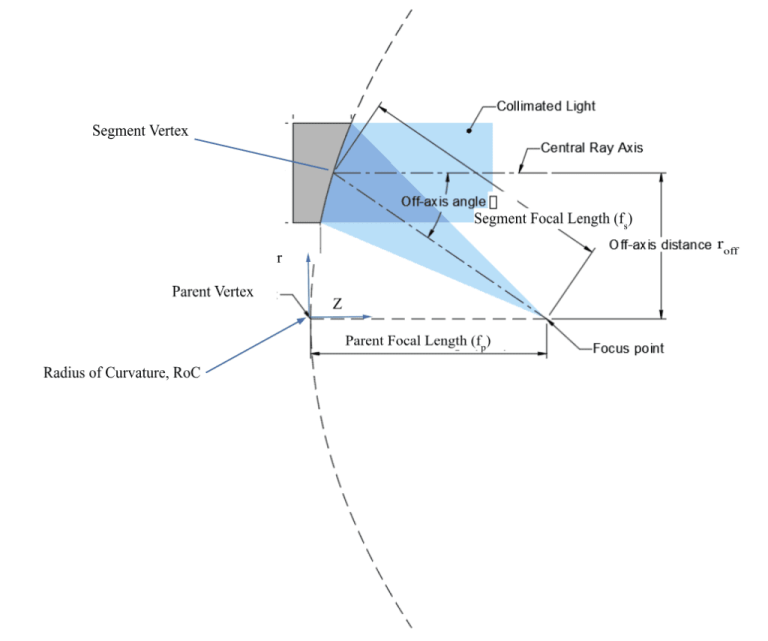
The “sag” or z-coordinate of the Standard surface is given by
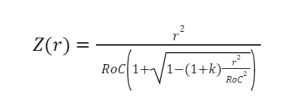
where
- RoC: parent radius of curvature at the parent vertex
- k: conic constant, is less than -1 for hyperbolas, -1 for parabolas, between -1 and 0 for ellipses, 0 for spheres, and greater than 0 for oblate ellipsoids.
- r: distance to the parent axis
- Off-Axis Angle: angle between parent axis and segment
- Z: surface sag in parent z axis
For OAP Mirror, k=-1, the equation is reduced to:

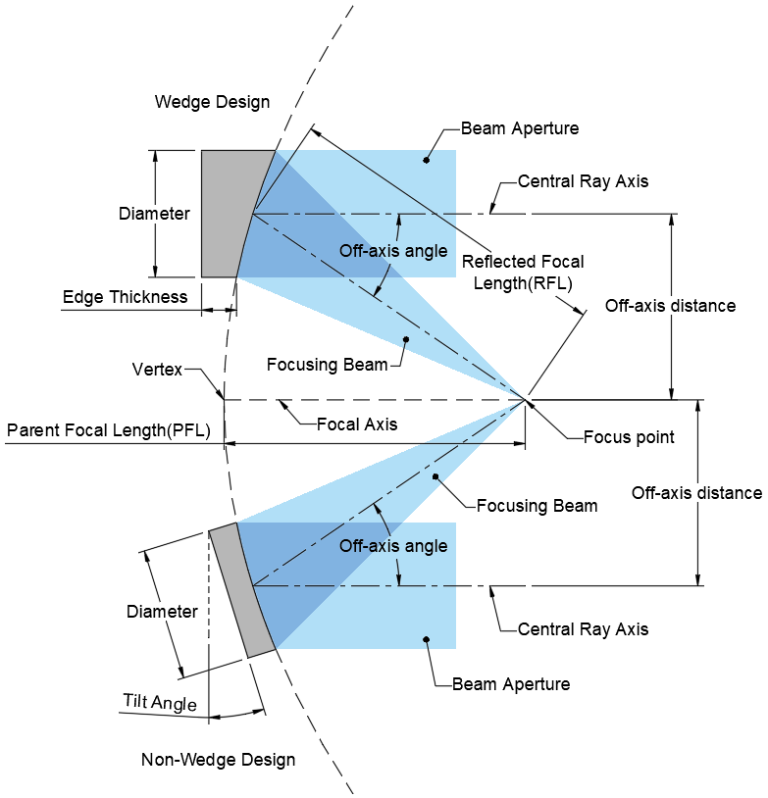
Design Considerations and Custom Options
In most optical setups, the beam aperture—whether circular or square—is aligned along the Z-axis. However, when the beam is reflected at an angle, the aperture shape projected onto the optical surface often appears elliptical or rectangular. This effect becomes more pronounced at larger off-axis angles, and can be a significant consideration in your design.
For applications involving large off-axis angles or large apertures, a non-wedge design can be a more cost-effective choice. In this configuration, a specific tilt angle is defined relative to the parent Z-axis, simplifying manufacturing and alignment.
Materials and Manufacturing
OAP mirrors can be fabricated from a variety of materials, including:
- Metals (machined via single-point diamond turning)
- Optical glass
- Advanced ceramics like silicon carbide (SiC)
Material selection directly impacts performance, cost, and achievable precision. For this reason, Avantier’s application engineers can help you choose the optimal material and surface quality for your application.
Coating Options
We offer coatings tailored to your selected substrate:
- Metallic coatings, such as protected aluminum
- Dielectric coatings, ideal for high-power laser applications requiring high damage thresholds
Built-In Alignment Features
Integrating alignment features into your OAP design can streamline system assembly and calibration. Avantier supports customers by recommending alignment features that are both manufacturing- and metrology-friendly.Key Parameters of OAP Mirrors
Clear Aperture
Defines the maximum diameter of the collimated beam the mirror can accommodate. It is typically circular to ensure optimal optical throughput.
Off-set Angle
Denotes the angle between the optical axis and the direction of incoming or outgoing light within the off-axis parabolic mirror.
Focal Length
- Parent Focal Length: The distance from the vertex of the parent paraboloid to its focal point. This remains constant regardless of the off-axis distance.
- Effective Focal Length (EFL): The practical distance from the mirror to the focal point along the reflected beam path, influenced by both the parent focal length and the off-axis offset.
Off-Axis Configuration
- Off-Axis Angle: The angle between the incident and reflected beam, usually ranging from 0° to 90°.
- Off-Axis Distance: The lateral offset between the paraboloid’s axis of symmetry and the center of the beam.

Custom OAP Mirror Examples: Precision Solutions for Diverse Optical Systems
Custom off-axis parabolic (OAP) mirrors are essential for advanced optical applications where precision, efficiency, and flexibility are critical. Designed to eliminate central obstructions and reduce aberrations, custom OAP mirrors enable high-performance beam control across a variety of industries—including terahertz imaging, astronomy, and laser systems.
By tailoring specifications such as aperture, focal length, off-axis angle, material, and coating, custom OAP mirrors offer optimized performance in even the most demanding environments.
Example 1: Custom OAP Mirror for Terahertz and Infrared Systems
In terahertz and infrared spectroscopy, optical accuracy and thermal stability are key to capturing reliable measurements. A large-aperture, custom-designed OAP mirror helped construct a highly efficient beam path with minimal wavefront distortion.
Project Specs:
- Mirror Type: Large aperture off-axis parabolic mirror
- Aperture: 300 mm
- Material: Zerodur
- Surface Accuracy: <1/3λ
- Coating: Dielectric film
- Off-axis Angle: 40°

Result: Exceptional reflectivity and thermal stability in a high-precision spectroscopy system. The mirror’s large clear aperture and sub-wavelength accuracy supported consistent data acquisition, even with environmental fluctuations.
Example 2: Custom OAP Mirror for Astronomical Telescopes
Custom OAP mirrors are highly valued in telescope design for enabling unobstructed, high-contrast views of deep-space objects. Therefore, a 400 mm OAP mirror was custom-engineered to reduce optical interference and enhance image clarity.
Project Spec:
- Mirror Type: Large aperture off-axis parabolic mirror
- Aperture: 400 mm
- Material: Fused silica
- Surface Accuracy: <1/2λ
- Coating: Protected silver (Ag)
- Off-axis Angle: 30°

Result: The off-axis design minimized diffraction and stray light, allowing sharp imaging of faint celestial bodies—ideal for modern astronomical research.
Example 3: Custom OAP Mirrors for Industrial Laser Systems
Laser systems demand accurate beam shaping and alignment. Consequently, Custom OAP mirrors ensure high reflectivity and tight focusing, making them perfect for laser processing, communication, and scientific instrumentation.
Project Specs:
- Mirror Type: Conventional off-axis parabolic mirror
- Apertures: 1 inch and 1/2 inch
- Material: 6061 Aluminum
- Surface Accuracy: <1/4λ
- Coating: Protected Ag or Au
- Off-axis Angle: 45°

Result: The mirror’s design allowed precise beam steering and high durability under intense laser exposure. Custom coating options matched wavelength-specific reflectivity needs, enhancing system efficiency.
Why Choose Avantier for Custom OAP Mirrors?
Avantier specializes in manufacturing custom OAP mirrors to match your exact system requirements. Whether you need a small-diameter aluminum mirror for a compact laser setup or a large, ultra-stable mirror for space-based observation, we deliver:
- Tailored designs based on your optical path and mechanical constraints
- Wide material options including glass, metals, and ceramics like Zerodur and SiC
- High-performance coatings for UV, visible, IR, and high-power laser applications
- Support from optical engineers who help refine specifications for best results
Related Content
WE CAN HELP YOU!
Contact us NOW for sales & expert advice.


